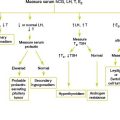Chapter 44 THROMBOCYTOPENIA
Causes of Thrombocytopenia
Congenital and inherited causes
Disseminated intravascular coagulation (DIC)
Maternal idiopathic (immune) thrombocytopenia purpura
Pregnancy-induced hypertension
Key Historical Features
Key Physical Findings
 Vital signs, noting fever or hypertension
Vital signs, noting fever or hypertension
 Growth parameters and comparison with previous measurements
Growth parameters and comparison with previous measurements
 General evaluation of well-being
General evaluation of well-being
 Complete skin examination for purpura, pallor, rash, jaundice café-au-lait spots, or telangiectasias
Complete skin examination for purpura, pallor, rash, jaundice café-au-lait spots, or telangiectasias
 Evaluation for lymphadenopathy
Evaluation for lymphadenopathy
 Abdominal examination for tenderness or hepatosplenomegaly
Abdominal examination for tenderness or hepatosplenomegaly
 Genitourinary examination for scrotal edema
Genitourinary examination for scrotal edema
 Extremity examination for edema, palmar erythema, or evidence of hemarthrosis
Extremity examination for edema, palmar erythema, or evidence of hemarthrosis
Suggested Work-up
| CBC with differential | To measure the platelet count and evaluate the other blood cell lines |
| Peripheral smear | To evaluate platelet size, WBC differential and morphology RBC morphology, and to rule out the presence of microangiopathic changes such as schistocytes, which might suggest another diagnosis |
| Coombs’ test | If an autoimmune-mediated thrombocytopenia is suspected |
| Antigen testing of mother’s and father’s platelets with testing of mother’s serum for antiplatelet alloantibody | If neonatal alloimmune thrombocytopenia is suspected |
| Transcranial ultrasound | Indicated in all severely thrombocytopenic (<30,000/μL) neonates to evaluate for intracranial hemorrhage |
| Prothrombin time, activated partial thromboplastin time, plasma fibrinogen concentration, fibrin degradation product, D-dimer | If disseminated intravascular coagulation (DIC) is suspected. In DIC, prothrombin time is prolonged, activated partial thromboplastin time is prolonged, plasma fibrinogen concentration is decreased, fibrin degradation product is increased, and D-dimer is elevated. |
Additional Work-up
| Bone marrow examination | Indicated for any child with thrombocytopenia with an atypical presentation or with thrombocytopenia lasting for longer than 6 months to evaluate for other conditions that could result in thrombocytopenia |
| Maternal platelet count | To distinguish alloimmune thrombocytopenia from autoimmune thrombocytopenia |
1. Bolton-Maggs H.B. Idiopathic thrombocytopenic purpura. Arch Dis Child. 2000;83:220–222.
2. Cines D.B., Blanchette V.S. Immune thrombocytopenic purpura. N Engl J Med. 2002;346:995–1008.
3. Kaplan R.N., Bussel J.B. Differential diagnosis and management of thrombocytopenia in childhood. Pediatr Clin North Am. 2004;51:1109–1140.
4. Roberts I., Murray N.A. Neonatal thrombocytopenia: causes and management. Arch Dis Child Fetal Neontal Educ. 2003;88:359–364.






















